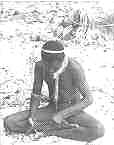No penny for the Onges?
 THE Onges, a minor tribal community comprising of about 100 members, residing in the Little Andamans - one of the 300-odd islands in the Andaman and Nicobar island group - may soon emerge as the messiah for the steadily swelling ranks of malaria victims in the country and the world. Only if they are not elbowed out of the arena by other more powerful usurpers of their traditional knowledge.
THE Onges, a minor tribal community comprising of about 100 members, residing in the Little Andamans - one of the 300-odd islands in the Andaman and Nicobar island group - may soon emerge as the messiah for the steadily swelling ranks of malaria victims in the country and the world. Only if they are not elbowed out of the arena by other more powerful usurpers of their traditional knowledge.
Even as India, especially its eastern belt, reels under a virulent attack of cerebral malaria, news has recently come from the Andamans that there exists in its interiors a particular plant whose extract can vanquish the dreaded malaria parasites. And most hearteningly, this is particularly active against plasmodium falciparum, the most dangerous of all the four malarial parasites which causes malignant malaria, and has now been found to be resistant to all the known anti-malarial drugs.
The Onges have been using the extract for generations as an antidote for fever and gastro- intestinal disorders. It also made them resistant to malaria, a disease that stalks the forests of Little Andaman, where constantly non-tribal inhabitants fall prey to it. This strange 'power' of the Onges was first noticed by a scientist working with the Regional Medical Research Centre (RMRC), a branch of the Indian Council of Medical Research, at Port Blair. He began testing the various plants that the Onges use for medicinal purposes, and discovered this magic plant. This, if properly developed and marketed, can give the human race-fighting a losing battle against malaria - a fresh lease of life.
But then, once the details and description of this wonder plant is made public, the forests of Little Andaman would be plundered by outsiders to gain exclusive rights over it. For, the stakes involved are enormous.
But the Onges - who should rightfully be the sole beneficiaries of the profits - may be left with nothing, say concerned environmentalists. "Because they are simple people and can very easily be persuaded to share their knowledge with rank outsiders," declares Samir Acharya of the Society for Andaman & Nicobar Ecology (SANE), spearheading the campaign to protect Onges' rights.
According to SANE, the RCMR scientist (he pleaded anonimity) who discovered the plant is being urged to publish the 'findings', so that a patent can subsequently be obtained.
The Onges, like the rest of the tribal communities who inhabit the Andaman & Nicobar Islands, have enough experience of the impact of the advent of foreign elements in their homeground. Over the last few decades, they have encountered the British first, and then settlers from the Indian mainland. The exposure has proved to be disastrous for the islands' pristine coastal ecosystem, as well as for the tribal people. But perhaps the most damaging factor has been insensitive administrative policies, which has pushed inappropriate development projects, causing largescale deforestation, destruction of mangrove forests and coral reef erosion.
In addition to all these, the unique lifestyle of the tribals and their exclusive customs and rituals is in jeopardy. Bereft of their natural habitat, which sustained their livelihood - comprising mainly of hunting and food gathering - they are being forced to depend on the money doled out by the brazen administration. The Onge culture has served as a brilliant example to sociologists and anthropologists of a treasure trove of invaluable indigenous knowledge about the seas, the forests and exotic plants preserved through ages. "But now most of it has fallen into disuse. And with the passing away of the older folk, the wealth of the traditional wisdom will be lost forever," rues Acharya.
In this backdrop, the need to protect and conserve the knowledge and resources of the local communities can hardly be overstressed, say activist groups in Andamans. For, as this particular case has proved, like the Onges, other communities too, can make valuable contribution to the pharmaceutical industry, to biotechnology and to other unexplored areas. But above all, what is required is the assurance that the indigenous peoples are involved in the design and implementation of these development initiatives, emphasizes Acharya. As of now, he and his fellow-campaigners are lobbying hard to get the Onges their rightful share of profits.
And perhaps, the Indian government - a signatory to the Biodiversity Convention that seeks to protect and acknowledge the rights of the indigenous peoples - would take this opportunity to develop a mechanism to ensure that patent-hungry scientists or muscle-weilding private corporations do no longer grab what is not theirs.
